– “The Best of the Decade Project” is an ongoing series of essays written by Match Cuts and The Filmist concerning the finest films of the last ten years.
What’s that, up on the hill-top?

We’re coming down to the tail-end of this project, now. The big three – the chart-toppers, the blind-siders. And, coincidently, also the hardest three to write about. And, in the whole short history of this site, I don’t think there’s one film-maker I’ve written more about than Australia’s own Dr. George Miller. How do you even introduce the guy? Myself, I’m still not quite certain, as the following paragraph will no doubt reiterate. The last of cinema’s thoroughly modern myth-makers – those implicit, anthropological followers of Campbell and Jung, before George Lucas arrived and gunked up the works – and a college lecturer on the indelible powers of those myths on our collectives psyches and their places in modern cinema, in his spare time. The single-handed spokesman for Australia’s burgeoning film industry, and their self-proclaimed answer to our own Steven Spielberg – although, that’s an arguable comparison, I think. Here is a director whose output has equaled one film in the past ten years – and, just one other film eight years before that; much like his contemporary Ridley Scott, his is a constant and laborious refining process, with the film here in question having taken the full eight years to fully realize. Of course, it probably didn’t help that after the production of Witches of Eastwick with Jon “hey, let’s have a giant mechanical spider in the third act” Peters, he’d been put of off Hollywood and directing in general for several years, only cautiously returning in the early nineties with Lorenzo’s Oil, but I digress. Within these films, despite the wide berth between their respective releases, there is one constant, underlying story, moving through different contexts, cultures and faces, out of thousands – whether man or penguin, woman or pig – conveyed through the ultimately humanitarian eye of a physician.
Happy Feet, like the Mad Max films and Babe: Pig In the City, begins with an expansive, mythological vision of a microcosmic world in the midst of great transition. The film begins quietly, in space, which will becomes a constant visual motif throughout the course of the film. A wide, vast cosmos is spread before us, like a shot from the Hubble – a nebula. And, in the middle of it, the faintest of familiar outlines – a mother penguin, her head bent down toward her young. At first, all we hear is the softest of voices behind the stars – a slow cover of The Beatles’ “Golden Slumbers.” And, then we begin to descend – down toward the Earth, as the noise begins to build. The planet takes center frame, spinning until Antarctica is at the top. And, it’s here, in these first thirty minutes, that the tone – or tones – of the film solidifies, constantly shifting from the serene and light-hearted into the sudden and potently mythological. From the parents of the main character Mumble meeting in a relatively bright unity of song, and into the huddle of the males in the harsh, bleak red light of the setting sun, set against the primeval chants of the colony Elders in praise of their food god, whose visage appears above them in the swirling winds. The juxtaposition of these two scenes together, and how they relate and reflect off of each other, epitomizes Miller’s use of tone for the rest of the film, with a slight emphasis on the latter aspect.

And, this is a mythic tale, fully realized – and, like Miller’s Mad Max films, intently so. Always, with the exception of the first Mad Max film, his movies have always been intently focused on the community, and the relationship of the outsider to that community; the outsider who becomes, in his words, an “angel of change.” Here, the world and the community at the center of his story isn’t quite as picturesque and water-color storybook as those found in the Babe films, and yet at the same time, it’s not quite as harsh and grim as those on the sand dunes of the Mad Max trilogy. Here is something entirely other, a fable in the truest sense. Everything in the film leads up to it’s second hour, after Mumble is forcibly excommunicated from his colony, becoming a pariah in the most spiritual sense – and, it’s here that Miller’s film hits its most mythic stride, with an archetypal camera tracking the penguin compadres through sweeping, vast – and yet, starkly minimal – ice-lands in search of the great Other: the much whispered-about “aliens,” the identities of which the film makes no secret about, because that isn’t the point. Here, Miller employs scale in a way that creates an eye-opening dichotomy between the penguins and their environment, always a constant factor – and, moving over them, those shadowy, almost god-like machines from without, breaking through the mist and ice, represented often in a ground sense of wonderment and fear – the mythic composition of the story comes finally full circle as Mumble delves off the ice cliff and into the Unknown, and Lovelace makes a vow to tell his tale, even long after his death. That’s how you do it, Lucas.
More than any of his previous films, Happy Feet is a film that defines its characters in terms of their surroundings – framing it’s characters in against the wide, barren expanse topped by vivid blue skies, and clouds that seem to go on forever. The main character’s father against a sudden and foreboding blue sky, watching the wives move off into the distance, and into the long, lonely night of winter ahead. Miller’s mastery of environmental mise-en-scene and composition is emphasized most clearly here, in the stark white wastelands of Antarctica. This becomes most obvious in what I consider to be one of the best scenes of the film, where Mumble and his compadres, against the eternally setting sun, attempt to cross a tundra in the throes of a massive blizzard, only to be constantly pushed back by the winds – shot in widescreen, the scene is really a simple battle to move from the left to the right of the screen, made into a force of wills. Leaning in to each other, bearing the winds, they make their way across – into the dark.
It’s also interesting how well thought out the primal religion of these penguins is – while it acts primarily as allegory, it seems also to have been implicitly crafted to fit into the same kind of naturalistic mold as the one found among the rabbits in Watership Down – it’s a food god they pray to, certainly. And, there’s a reasonable skepticism apparent here and there in Miller’s Thomas Aquinas-esque reconciliation of faith and reason, science and religion, the individualist and the collectivist, represented in the smaller community of the colony, also indicative of his oft-quoted philosophy, cribbed from astrophysicist Paul Davies, that “science is a faster way to god than religion.” There’s a bit of the Carl Sagan here as well, remaining from Miller’s time on the film version of Contact – it isn’t overly cynical about the mythology that holds this penguin community together at the bottom of the world, and it even seems fascinated by it, despite the machinations of it’s Pharisaic Elders. This is a colony that must remain welded together to survive in this harsh wilderness, and indeed, the emperor penguin is the animal most emblematic of collectivism – and, it is this purpose that their mythology serves, as the concrete of their society. At the same time, there’s also a slight unwillingness and uncertainty about it, in hushed whispers at first – which culminates in the zoo sequence near the end of the film, where Mumble steps out of his plastic enclave for the first time and into the white light of the aquarium. And, upon asking where this place is, the only answer he gets is, “You’re in Heaven. Penguin Heaven – and, it’s wherever you want it to be.” It seems more focused on the personal relationships inside of this culture – of Mumble to his father Memphis, particularly, and the continuously developing arc of his father, by itself, as more and more his guilt overwhelms him over the course of the film until, by the end of the film, he finds himself as spiritually dead as Mumble was in the zoo.

Mumble the character is an idealist, as much as Max was a nihilist, and constantly, Miller places this idealism – or naiveté’, some would say – at the behest of a violent and often cruel world. As with all of his films, there’s an emphasis on the essential safety that the community provides, in the wasteland, and the inability of individuals to live outside their environment. The farther away that Mumble gets from his tribe, the more immediately dangerous the world around him seems to become – gradually, the size of the predators pitted against him increases, from a skua bird to a leopard seal to a killer whale – until, he ends up in a zoo, continents away. And it’s here, in this sequence in the zoo that Miller breaks the character down toward his “essential self.” As Matthieu Santelli notes, “the film revives the theme of the Mad Max trilogy and the Babe films, when the crossing of the line becomes inevitable. The danger in Miller’s films always comes from the other side. And, if they walk too far, they may find themselves trapped.” Yet, it’s only there, after months of isolation and being driven toward near-insanity, that he finds what he’s been looking for – just on the other side of the glass. And always, a cautious sort of optimism that acts as the real through-line between this and the latter two Mad Max movies, and everything in between pervades the film, even in its most darkest moments, when the main character finds himself screaming his lungs out at the faces behind the glass, staring down at him.
Music, and rhythm, both take an especially active role in the film, as well – the pinnacle of these penguin’s culture is the “Heartsong,” coming from the natural practice of the Emperor penguin’s mating rituals, represented here in iconic fashion through the use of prior-recorded music – and, it’s through this that we’re informed of much of their world, in more ways than one would think, initially – it becomes Miller’s centralized way of representing the unease growing within the penguins’ community; along with the use of The Beatles’ “Golden Slumbers” at the beginning of the film, mirroring it and bookending the movie is a rendition of “The End,” from the same album – and, to parallel the religious, almost ‘prophetic,’ subtext of the film, Gloria’s song during the two’s courtship ritual that marks the midpoint of the film is a simultaneously somber and bombastic rendition of Earth, Wind and Fire’s “Boogie Wonderland,” a song about the loss of faith in prayer – and bell-bottom jeans, but I digress. And always, following the character is an almost Gregorian soundtrack, reminiscent of the chant of the Elders in the Huddle sequence near the beginning of the film, and repeated in defiance of the dancing below again near the end. When Mumble is awoken from his dormant egg early on in the film, it’s by the tapping on the shell by baby Gloria. Later on in the film, it’s this same rhythmic tapping, on the glass of the aquarium exhibit, that startles him from his emotional death – and into a rebirth, in a sequence that returns Miller to what he’d found so fascinating about cinema in the first place, images without sound, “visual music” in the clearest sense.
And in keeping with that train of thought, this – like most of Miller’s films – this is a movie fascinated with the possibilities of cutting – which becomes most apparent in his musical sequences. Musicals have always seemed like the brother or sister to action films, with their collective emphasis on the kinetics of cinema – and here, Miller takes full advantage of that, adapting his headlong, constantly moving and almost aggressively lyrical style to the unification of image and music, song and rhythm, voice and dance. In a way, it’s a return to the style of the classical musicals of the forties and fifties, like Stormy Weather or Singin’ In The Rain – I hazard to mention Busby Berkeley, because what most people miss with his musical sequences is that they were entirely meant as pure escapism with little relationship otherwise to anything else in the films they were in, which isn’t the case here – but at the same time, it’s also a furtherance of those ideas, with a cast of thousands, spanning colonies and, in the final sequence, continents. A Blue Angels-esque musical sequence that, for the penguins, represents nothing so much as the equivalent of spring break, a courtship ritual that breaks out of its boundaries, a rebellion against the perched, and a celebration.

The role of Mumble is a three-way composite between Elijah Wood, Alan Lee, and Savion Glover – and, as a tap-dancer myself, it’s Glover’s role as both the character’s feet and the general choreographer of the film that gives the character an almost iconic feel, much like a Babe or a Max, or even an Odone; in contrast to what candy-colored Broadway floss might have come if someone like, say, a Simmy Slyde had been brought on, Glover gives the character an individualized and gradually evolving artistry to the noise he’s creating with his feet – sometimes it’s very “light and bright,” and other times it becomes “real hard and heavy,” to use his own terminology. There’s a real love and respect apparent here for the form, inside the film and out – it isn’t trivialized, and it isn’t made fun of, as most expected it would have been. It’s respected, certainly. And along with the character, the use of dance gradually evolves throughout the film, becoming larger and more unifying – first as a method of personal expression, and then of courtship and love, which is followed by it’s shift into something a bit more primal, a tool of mass rebellion and defiance, against those up on the perch above, who do their best to drown it out with their own ritual noise. And, as the helicopter arrives, all falls silent for a moment – before the penguins begin to move again in unison, following their new leader at the back. And, finally, dance becomes a tool of almost universal communication, as revealed by the final sequence.
There are actually a lot of interesting ways to look at the film – as a religious allegory, as a veiled alien abduction story, or as the meeting of two societies and cultures, the Indians and the Spanish, among them. I remember once, a while back, reading someone’s essay comparison between the film and James Cameron’s The Abyss, and – you know, it does make sense. More simplistically, it could be a love story, a tale of the outcast, or even the gap between the new generation and the old. Or, it could be all of those things. Whatever you consider the film – a piece of children’s cinema in the vane of Golden Age Disney, a new sort of mythic fable from the same class as Martin Rosen’s Watership Down with a sense of humor, or something that sits somewhere in between – there’s no doubt in my mind that it is something indelible, and will remain.
***
Interestingly, in my bits of reading and research about the film, here and there, I came upon an intriguingly early, and unnaturally disturbing, piece of concept art – see what you can make of it.

Like most of the other films on this list, there are a great many articles published examining the film from several other angles, though most of them are French – being the country where the film seems to have demanded the highest degree of respect. Among them are Matiere Focale’s (roughly translated) “Happy Feet: Do We Need A New Hero? (Is There Any Escape From the Noise?)” and, the counterpart to our own CinemaBlend, Critikat’s own look at the film’s editing schemes in relation to Miller’s previous films; also of note is fellow stateside blogger Davey Morrison’s recent essay, “Happy Feet: The Expansion of Spiritual and Moral Point-of-View,” which examines the film’s use of subjective camera, among several other things. Finally, there’s Glenn Heath’s own unpublished analysis of the film as a whole in tandem with Miller’s other works, from which several ideas here and there in the preceding article were sprung, and which hopefully will in the future see the light of day on his own site.
Speaking of ol’ Glenn, his respective #3 entry, David Lynch’s mind-numbing Mullholland Dr., can be found right – over – here.
** This article was selected by The Dancing Image as one of their picks for the best pieces of blog writing on film from ’09, as of December 29th, 2009. Not bad.
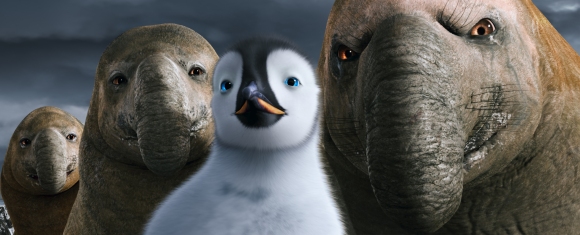
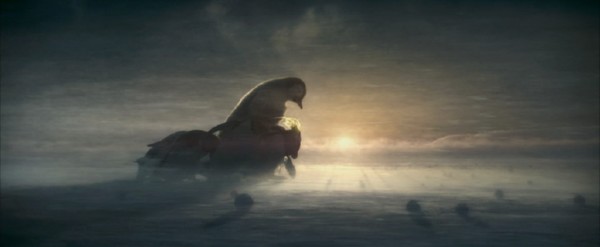









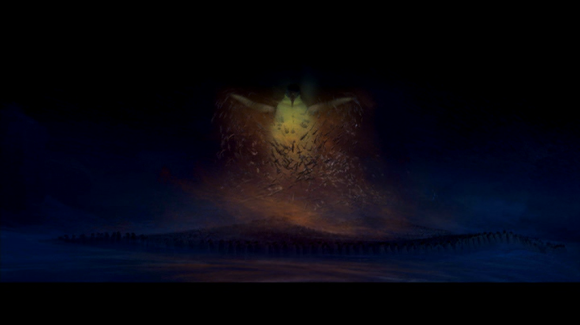
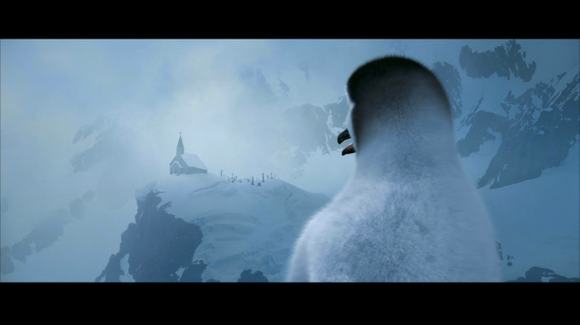 from George Miller’s “Happy Feet.”
from George Miller’s “Happy Feet.”

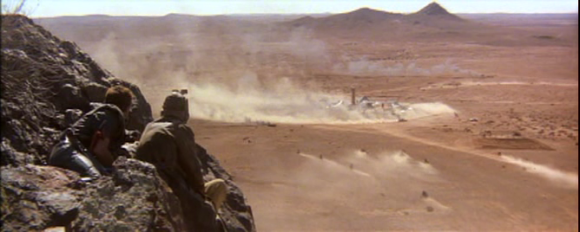


 from George Miller’s “Mad Max 2 – The Road Warrior.”
from George Miller’s “Mad Max 2 – The Road Warrior.”